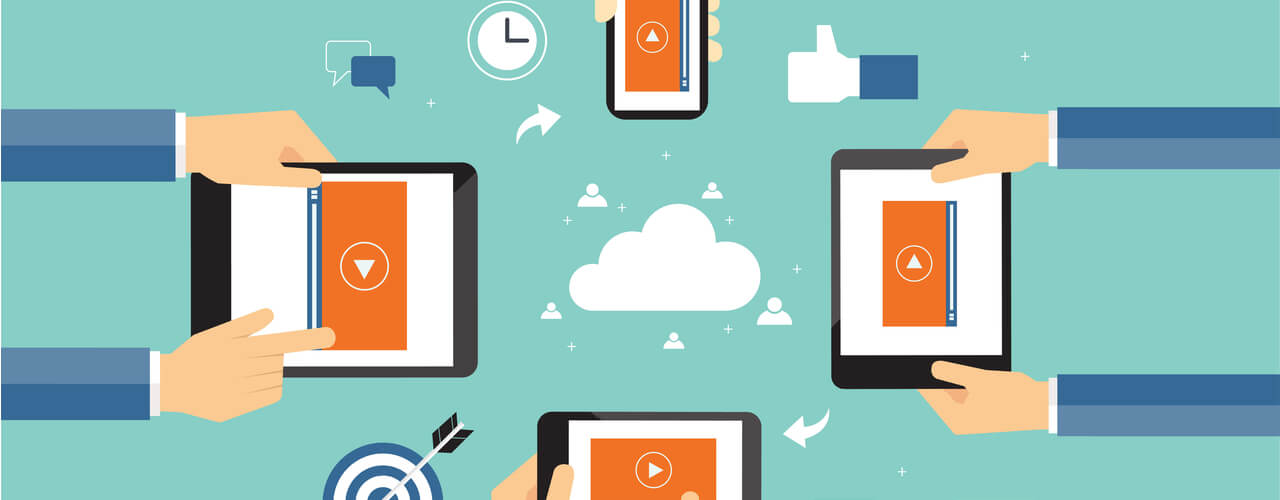For some business owners, it might be difficult to try to establish their businesses online for the first time or even enhance their reach — especially during the pandemic, when technology has overtaken the way we communicate. So, what are the first steps to do so? And, how can you enhance your business’ reach if it’s minimal? Also, what have customers been looking for in online marketing since the pandemic began, and should you continue physical and offline marketing?
To find out, CommercialCafe discussed these questions with several leading experts in online marketing. Read on for their useful insights that might be beneficial for your company.
Meet our Experts

Matt Bentley
Founder and CEO of CanIRank

Matt Bertram
Co-Owner and CEO of EWR Digital

Allison Chaney
Chief Digital Training Officer at Boot Camp Digital

Joshua Feinberg
Chief Thought Leader, Vice President, and Co-Founder of SP Home Run

David Galownia
CEO at Slingshot

YY Lee
Founder of Zoewebs

Kent Lewis
President & Founder of Anvil Media

Jason Parks
President of The Media Captain

Brian Robben
CEO of Robben Media

John Ross
CMO at Test Prep Insight

Lara Schmoisman
Founder & CEO of The Darl

Rebeca Sena
Founder & CEO of GetSpace.digital

Justin Smith
CEO of OuterBox

Daniel Snow
CEO & Founder of The Snow Agency
What are the first steps for a company looking to establish an online presence?
Matt Bentley
“Create an online presence by registering for several types of accounts online. You can start with the social media accounts, including a Facebook business page. The most important step from an SEO [search engine optimization] perspective is creating a website with engaging content and a clear call to action. You also want to set up a Google My Business account, Yelp profile and other listing directories to establish a wider presence.”
Matt Bertram
“Search engine optimization (SEO) is one of the best strategies to build your online presence. When executed correctly, SEO will give you free traffic to your website that you can convert into paying customers. Start by using keyword research to identify your target customers’ search queries and creating informative content around these keywords.”
Allison Chaney
“Build a website so you have a credible web presence. Then, set up your Google My Business page, and claim and verify it and complete it to 100%.”
Joshua Feinberg
“Set SMART goals to focus your efforts. SMART goals are specific, measurable, attainable, relevant and time-bound. For some companies, it’s lead generation. For others, it’s about nurturing existing leads or remarketing to existing customers.
Identify the most important stakeholders. In much the same way that goals help prioritize limited resources, very few companies have the resources to market to everyone. It’s much more practical to figure who your most important buyer personas are, what companies these stakeholders are part of (ideal client profile), and what their buyer’s journey looks like.
Develop educational content, also sometimes referred to as thought leadership. The way people research and make purchase decisions has changed dramatically, especially during the lockdown. It’s super-critical for companies to have a way to intercept potential clients early in their research process and use helpful content to educate and build trust.”
David Galownia
“Your online audience will be different from your in-person audience. You’ll want to build everything based on evidence, so do some research on who that might be. Interview your current users and get their thoughts on your current processes, similar online processes and your competitors’ processes. This way, you won’t get leading answers. If you ask if someone likes an idea, they’re much less likely to say no. These interviews should more so be to gain insights on current pain points and then plan features and next steps based on that.”
YY Lee
“Set up your own corporate website. In the offline world, your office/shop is your main location where your people, facilities, product [are] based. In the online world, the corporate website should be the main place to tell people everything about your business and your contact [information].”
Kent Lewis
“In order to successfully transition to a digital customer experience, brands must first understand their customers’ journey. I recommend auditing customer journeys across a sample of different types of customers/segments/personas and map key touchpoints. Once the journey is mapped out, audit your brand’s efficacy at addressing key messages at various touch points along the (digital) journey. Are messages consistent? Appropriate to the media type and context? Are those messages and calls to action creating the desired outcome? New for 2020: Assess how your brand has adapted to the pandemic and adopted various low-touch and no-touch interactions. The benefit of digital is that it empowers a COVID-safe alternative to product and service delivery.”
Jason Parks
“You need to build an e-commerce site. Before doing this, it’s important to solidify your branding (domain name, logo and color scheme).”
Brian Robben
“Create a website or hire a website design agency. Your website is the headquarters of your online presence. Once you have this, then you can focus on sending high-quality traffic to the site.”
John Ross
“After building your website and launching it, the first thing you should do is make your business visible in online directories. This means registering your business on Yelp, Google Business and other sources where you are free to share your new site’s existence. I would then immediately follow that up by setting up social media accounts (if your company doesn’t already have them) and connecting them to your website. Lastly, I would start building links to your website. This is the toughest challenge and will take some skill, but link-building to your site is the only true way to be found in organic search.”
Lara Schmoisman
“Definitely build your ecosystem. What I mean by ‘ecosystem’ is a strategy we live by here at The Darl, where everything is always interconnected under one big umbrella — each marketing piece connects with the others, as if they were parts of a puzzle. This is done because one element should not be isolated from the big picture of the digital jungle. Everything must be intertwined in a way that makes sense.
Nowadays, we live in a competitive and crowded digital ecosystem. How our brand’s message is delivered is one of the most important things we should be aware of. And, when creating digital marketing content, it’s essential to understand and make use of it. Only a cohesive and consistent brand message will help relay an effective message.”
Rebeca Sena
“Establishing an online presence should start with creating a website, claiming a Google My Business listing and opening one to two business profiles on social media. All of this together will bring credibility and enable potential clients to find your firm’s contact details when they search with its name.”
Daniel Snow
“Companies with a minimal online presence can establish reach by creating a website and a few social channels where their ideal audience is hanging out. All you need are a few solid channels where you can create or curate and post content relevant to your business — content that provides value to your customers. Then, reimagine and repurpose that content on one or two targeted social media channels. Get yourself interviewed on podcasts, video shows, Facebook, or LinkedIn Live to help establish your brand authority and grow your SEO.”
How can a company with a minimal online presence enhance its reach?
Matt Bentley
“A company with a minimal online presence can enhance its reach by reevaluating its website content. Take a look at how you’re using your SEO keywords. Be sure to also take advantage of your website’s on-page elements. SEO tricks are always changing. Stay up-to-date and you’ll find your website creeping up in the Google rankings.”
Allison Chaney
“Google My Business is a great place to start. With little effort, you can use this free tool to add your business information to a database that is widely used across numerous platforms.
Social media is also a powerful tool for amplifying your reach. Be consistent and post valuable content that connects with your audience and start building a conversation and relationship.”
Joshua Feinberg
“Size up your competition. Ten years [ago], you were really ahead of the curve if you had a great blog, YouTube channel and LinkedIn presence. Today, most companies are in hypercompetitive marketplaces where it’s a battle to earn attention. How are your competitors doing with their online presence? That’s very important to know.
Recognize that most search and social channels are now essentially pay-to-play. While there are some exceptions, once you’ve built high-perceived-value thought leadership and with an efficient lead-generating landing page, consider using all that great buyer persona research you did to invest in some highly targeted paid search and paid social campaigns to drive leads within hours of going live.
Build for the long-term. Now that you have deployed paid search and paid social campaigns to drive more immediate results, take steps now to repurpose your same content as blog posts, social media posts and videos — to grow your search engine authority and organic social media reach. This will almost certainly take considerably longer to see results from versus paid search and paid social campaigns, but is generally an excellent intermediate- to long-term investment. Just be sure that most of the content you create is reasonably evergreen so you can maximize its
shelf-life.”
David Galownia
“It really depends on your target market. B2C products usually do best on pre-created platforms (Facebook, Instagram) since it’s harder to get people interested in your product. For B2B, you’ll want to build credibility and your expertise. This usually means creating your own ‘platforms’ online: a quality website, a web system or a mobile app.”
YY Lee
“If you have a budget, then you can hire a digital marketing agency to plan a strategy for you. You can promote your business within your budget. But, if you don’t, you can do it yourself by starting with Google Maps. Eighty percent of people use Google Maps to search for local business[es], so the appearance in Google Maps is very practical. After placing your location in Google Maps, then you can proceed with social media [platforms] that you are familiar with. You can create a business page on social media.”
Kent Lewis
“The best way to enhance reach online is to create and optimize a website to maximize visibility in search engines for popular search terms. While creating and updating social profiles can help generate awareness, you don’t own the platform or have control over the relationship as you do with a website. A WordPress website can be nearly free to design and host, and your website can evolve with your business and customers.”
Jason Parks
“For an e-commerce website, you can scale with Facebook/Instagram or Google Ads. Between those two channels, you’ll typically find a top-performer.”
Brian Robben
“Go all in on one digital marketing channel when your reach is minimal. A restaurant could focus 100% of their energy on Instagram. A software company should go after Twitter. And, a media company should invest in YouTube marketing. When you have a minimal online presence, you don’t want to spread out your reach by a small margin to a bunch of other platforms. Focus on one, dominate and then move on.”
John Ross
“The easiest way for a company with little online presence to expand its reach is PPC [pay per click] advertising, plain and simple. Growing your web presence organically is a slow process and takes lots of time. If you want to grow your reach quickly, use Google Ads. Keep your budget small at first, but start running ads against keywords that are critical to your business. Even just a few dollars per day will take you a long way in terms of reaching a new audience.”
Lara Schmoisman
“You’ve probably heard this before but, truly, in order to build an online presence, you first need to find your niche — that is, the specialized segment of the market that you will aim for. Once you’ve found it, you also have to understand your niche. It allows you to differentiate yourself, make a statement and stand out from your competitors.
Besides, bear in mind that the digital and technological world is constantly changing, so we need to be on top of our game — all of the time — adapting and learning the new rules. We need to become proficient in reading data, but the most important thing is how we analyze information and then use it. This is why, once you know your niche, it’s important that you’re also aware of key players in the industry and what real-world events could affect it, and how you will differentiate from them.”
Rebeca Sena
“Precisely describing the scope of services and company specialization on the website, social media profiles and GMB [Google My Business] can help tremendously. That’s especially the case if the company operates in a niche segment or doesn’t have much local competition. Enhancing the use of references to sector-specific services may bring it to the top of the search results for highly specialized buyer keywords, like ‘residential architects for Victorian houses in London.”
What have customers been looking for in online marketing since the pandemic began?
Matt Bentley
“A lot of customers are looking for remote-friendly services since the pandemic hit hard last year. All meetings are essentially done online now via Zoom or Google Meet. It’s not only safe, but convenient, too. My digital marketing consulting firm practiced a remote work and flexible hours policy since we launched in 2010. It’s really exciting to watch the entire world take advantage of these tools at our fingertips.”
Allison Chaney
“Connection and relationships. More than ever, we’re feeling disconnected. Any type of human connection — even through a screen — is vital to survival. Create content that connects with your audience in a way that makes them feel seen and heard and felt by your brand.”
Joshua Feinberg
“Create value by teaching first. The overwhelming majority of your target prospects are looking to gather information, address goals, and solve problems when looking up a query on a search engine or asking about something on social media. To enter the conversation going on in your prospect’s mind, it’s super-critical to be contextually relevant. By sharing helpful content, you will earn mindshare as you educate and build trust — which will make your prospects way more likely to come back to you when they’re further along in their buyer’s journey.
Don’t make the super-common rookie mistake of proposing marriage on the first date. If you sell a high-ticket product or service with a considered sales process, it’s doubtful that you’re closing the sale in the first conversation. And, even if you did, are you really sure both parties did their homework so there’s no buyer’s remorse? Remember, in a world where happy customer reviews help attract more happy potential customers, unhappy customers leaving lousy reviews can really stall your company’s growth.
Respond faster than fast. Courtesy of innovators like Amazon, Doordash and Instacart, most people are now conditioned to expect immediate gratification. Think about what you can do with self-service tools — such as chatbots or knowledge base — to help people self-serve even when your team isn’t available. However, during business hours, make it a priority to respond as rapidly as possible. All the latest research confirms that your ability to connect with and qualify a prospect drops sharply after as little as five minutes.”
David Galownia
“Quality and connection. You’ll want to show your consumers that no matter where you are, they’re getting the same or even better experience than if they were in person. This means that, when connecting with your audience online, you’ll need to make sure that what they’re seeing and interacting with is quality. Everything should be easy to use and load quickly.”
YY Lee
“Since the pandemic, a lot of customers [have been] looking for product and services online. So, a lot of businesses want to be able to appear online when customers search for their services. Hence, the demand for online advertisement [and] Search Engine Optimization (SEO) has increased.”
Kent Lewis
“Customers (agency clients) are looking for affordable, measurable marketing. That typically translates to search engine optimization (SEO) and digital advertising (PPC/social ads). Consumers (end-users) are looking for the most useful information possible when searching online or navigating websites like Amazon or mainstream media websites.”
Jason Parks
“We’re seeing a lot of demand in the beauty and skin care industry. Self-care is really popular right now. Any product that fills a need can sell via e-commerce.”
Brian Robben
“Customers want minimal friction and easy navigation to reach their destination. For example, make your shop page a one-click checkout, if possible. It’d be a poor experience and you’d lose sales if it takes five clicks to checkout of your online store.”
John Ross
“As everything continues to shift online, users want to see a clean and professional site. If your company is unknown to them and you have a site that looks spammy or low-quality, they will hit the back button in a second. You need a site that is fast, professional and modern. Without this, you’ll never be able to get new visitors to stay on your page. There are just so many quality sites available today that professionalism is becoming the new norm. So, invest in the quality of your site build.”
Lara Schmoisman
“Easy, valuable content. In today’s market, covering the customer’s necessities is just not enough. Your brand must offer an actual experience. This experience is what will differentiate your brand from the rest and will keep customers coming back.
The way I connect with my customers or potential customers is through storytelling. Every marketing strategy we create has to have a story behind it. Storytelling is what brings a brand to life. It gives your business a heart and soul.
Content is KING. Therefore, content marketing is important not only because it creates brand awareness, authority and helps to position the brand, but also because it builds trust by creating customer loyalty, which is essential to retain current customers or acquiring new leads.”
Rebeca Sena
“Although many customers have lower disposable income than pre-pandemic, most of them spend more time browsing the internet. Even if they can’t afford things, they are still willing to plan many purchases. That opens the opportunities for acquiring new audiences, which is an investment for the future. Even if such website or business profile visitors remain observers, it will eventually bring conversions when the economy rebounds. The companies with lengthy customer acquisition funnels can benefit from it the most.”
Do you think an online presence will continue increasing in importance even after the pandemic?
Matt Bentley
“Once the pandemic begins to wind down, there’s no way the world is going back to the way things were 100%. Everyone has already got a taste of the benefits of an online presence. The convenience and ease of doing business online is so much faster. From SEO marketing to real estate to healthcare, taking advantage of online platforms like Zoom and Asana make it easy to get things done.”
Matt Bertram
“The pandemic has permanently shifted consumer behaviors. People have become accustomed to the convenience of shopping online, coupled with more competitive prices and a greater variety of products. I do not expect this shift to reverse even when restrictions to online shopping have been lifted.”
Allison Chaney
“Absolutely! People are starting to experience some of the massive benefits by using digital tools to connect us. It bridges gaps that existed before the pandemic and will exist after.”
Joshua Feinberg
“Yes. With tens of millions of Americans now researching and making major purchase decisions 100% online, most of these shifting habits are likely here to stay. Even though I consider myself pretty digitally savvy, before March 2020, my family and I had never ordered a full order of groceries online. Fast forward a year later, and none of us have been inside a supermarket, drugstore or warehouse club since then. When restrictions are fully lifted, I’m sure we’ll have some nostalgia and yearning to have traditional shopping outings. But, the extreme time-savings and convenience have now permanently shifted our habits.
Now that so many companies have figured out that it is possible to close large five-, six-, and even seven-figure deals 100% over video conference, business travel will permanently change. There will be some bounce back, but it’s likely that the days of flying an entire sales team across the country for a one-hour meeting may have already met its digital replacement.”
David Galownia
“Absolutely. Business is changed forever. Consumers have been interacting almost entirely online for over a year now. While in-person traffic will return once it’s safe, it won’t nearly be what it used to be. Consumers have discovered they don’t have to be in person for everything, and that mindset will continue.”
YY Lee
“Yes, online activities have increased tremendously during the pandemic. More people [are getting] used to it and have knowledge of using the internet. So, an online presence not only will become important, but will also become more competitive.”
Kent Lewis
“Absolutely. I’ve been building and optimizing online presences for clients since 1996 and it’s only increased in importance over time.”
Jason Parks
“Yes. The penetration of e-commerce in the United States has grown exponentially during the pandemic, but it’s nowhere near China’s market share. There’s still a lot of room to grow in the U.S. (and elsewhere).”
Brian Robben
“The necessity of online importance is here to stay. From young kids to senior citizens, the pandemic forced everyone to get up to speed on their technology skills. Now navigating Google search and finding businesses is a way of life.”
John Ross
“I have no doubt that web presence will continue increasing in importance even after the pandemic. Customer preferences and habits have been permanently altered to favor digital research, purchasing and engagement. It will only continue to gain importance as time goes on.”
Lara Schmoisman
“Absolutely. Even before COVID, it was evident that the future is digital. The pandemic only proved it, and I’ll give you an example. In The Darl, we made our presence stronger through content like newsletters and special promotions that were specifically designed for quarantine and social distancing times. We added more interactive approaches, such as Instagram and Facebook Lives, giving our audience a chance to engage with the brand and see a whole new side of us. As a result, we’ve increased our viewer rates and overall engagement.
The truth is, in this digital world, it’s all about being relevant and having authority. We’ve been given incredible platforms, which we can use to our advantage for both personal and professional use. Not taking the time to build an online presence is like not showing your baby to the world, and not exploiting the tools you have in order to thrive.”
Rebeca Sena
“The online presence has already overtaken many offline activities. The customers and businesses alike were forced to move a great part of their communication online. Informing about modified opening hours or changes to the product/service range have been done through emails instead of being announced at the storefronts. And, that will likely remain as short informative email or Facebook updates are convenient for both sides.”
Justin Smith
“While the pandemic forced many businesses to make the move online, it only sped up the inevitable. In today’s digital world, it is imperative to have an online presence and the pandemic made that all the more apparent. While it’s hard to say when the pandemic will end, I believe that it has forever changed consumers’ buying habits and made them increasingly reliant on online shopping. Businesses that don’t adapt will, unfortunately, get left behind.
Since the pandemic started, we’ve seen a dramatic rise in traditional brick-and-mortar businesses making the move online, and that trend shows no signs of slowing down. If anything, we believe it will continue to accelerate in the months and years ahead.”
Should companies keep up with physical and offline marketing? In what ways?
Matt Bentley
“Companies should maintain their online presence, while still keeping a physical presence. Now that vaccines are rolling out and people are going to begin feeling comfortable about going out more frequently, physical and offline marketing will still be necessary. Online marketing, however, will remain integral to reaching a wider audience.”
Matt Bertram
“Despite the overall trend of marketing shifting to digital, there are still advantages of offline marketing. Offline marketing looks more credible, builds trust faster, and creates a more lasting impression on customers. In addition, offline marketing can reach certain demographics, like older people who prefer not to be online.”
Allison Chaney
“Yes, but in ways that integrate more seamlessly with digital. We’re finding that there is a lot of waste in certain types of marketing, and with digital, we can save resources and communicate more effectively.”
Joshua Feinberg
“Yes, companies should think about how physical and offline marketing stays relevant. However, from now on, all companies will seek to measure physical and offline marketing under largely the same lens and scrutiny as their online marketing.
Before COVID-19, many companies invested most of their marketing budgets on offline events — especially lavish trade shows, golf tournaments and group outings to major sports events. And, a much smaller percentage of the overall marketing budget went to website development, content creation, SEO, social media, videos and webinars.
As we emerge from the pandemic, the massive shifts to all things digital over the past 12 months are likely permanent. And, it’s the trade show booth and golf tournament that has to battle for a small slice of the remaining marketing budget.”
David Galownia
“Offline is still going to be important once the pandemic is over. However, I do think that it will decrease in effectiveness. Once it’s safe to be in person, evaluate your in-person versus online customers and adjust your budget accordingly.”
YY Lee
“Companies should still keep up physical and offline marketing because offline and online marketing can compensate each other. Physical appearance gives a trust value to the corporate. But, the resources should be shared among online and offline marketing. For example, we shouldn’t be too aggressive in opening new branches because it’s very costly. But, we should also look at online marketing where there are many potential opportunities.”
Kent Lewis
“Yes, as post-vaccine behavior will return to normal and offline marketing will be important — especially for retailers, restaurants and any business with a physical presence. Marketing is a pie and consists of a variety of slices (media channels) that should all be addressed in some way, including print/broadcast advertising, PR, events and direct mail.”
Jason Parks
“It depends on your business. It can still be important to have a brick-and-mortar location if it’s conducive for your business. There will be a demand once the pandemic is over for malls and shopping, so it’s good to diversify — especially if your product sells well in physical retail environments.”
Brian Robben
“If you can afford to, then the more marketing, the better. Extra marketing will lead to more prospects knowing, liking and buying from you. It’s not the best product that often wins, it’s the most marketed one. Sending amazing offers through the email is always a winning idea. Another option is to have a catchy sign if you’re a retail location. Those are tried-and-true solutions.”
John Ross
“In my opinion, there is still a place for physical and offline marketing. I actually think billboards are still an effective marketing technique. They may be one of the oldest forms of advertising around, but they are still shown to be effective. As long as you have good creative, billboard ads can get a desired effect, though I would really try to limit them to local businesses.”
Lara Schmoisman
“Marketing isn’t one-size-fits-all. The fact that something worked for a friend or another company does not mean it will work for you. Each business is unique, so you need to create a strategy that is uniquely tailored to it YOU. I honestly believe every business is unique and individually needs to analyze where they will be standing after the pandemic and where they are now.
And, although, in recent years, online channels have grown tremendously, offline marketing still has [its] own potential. It’s key to understand that they don’t fight each other — they work together. The customer journey is the sequence of both online and offline touchpoints. Once again, it’s not one or the other. It’s not the importance of one specific tool or skill. It’s the combination of both. As I like to say, you need all the pieces to build the puzzle.”
Rebeca Sena
“In the long-run, offline marketing is not completely going away. However, in the era of constantly changing sanitary regimes, its role is vastly reduced as customers spend much less time in the brick-and-mortar locations. Nevertheless, businesses that can’t operate fully online should make sure their offices or venues are properly marked and their opening hours highlighted. It’s quite easy to get omitted when being the only open store on the street.”
If you found this article useful and informative, please feel free to check out our Expert Insights & Roundup Series.




[…] Online Marketing Experts Advise Companies on Going Digital COMMERCIALCafé […]